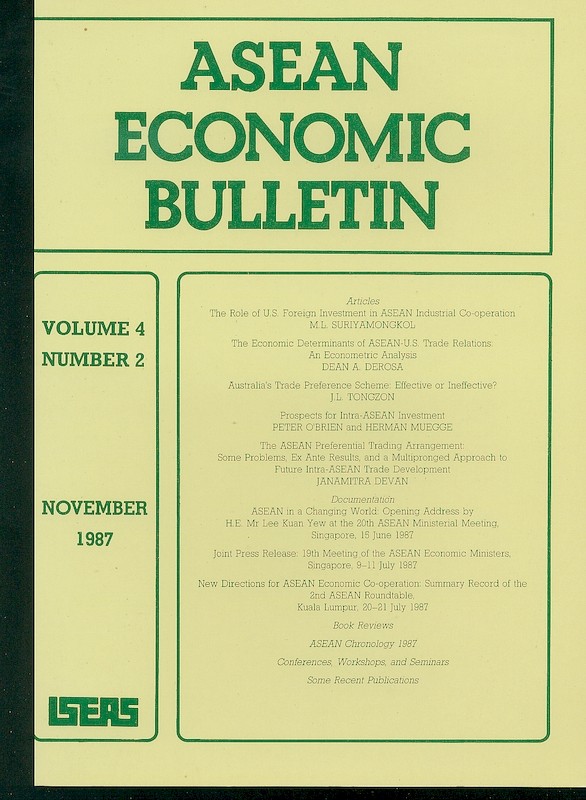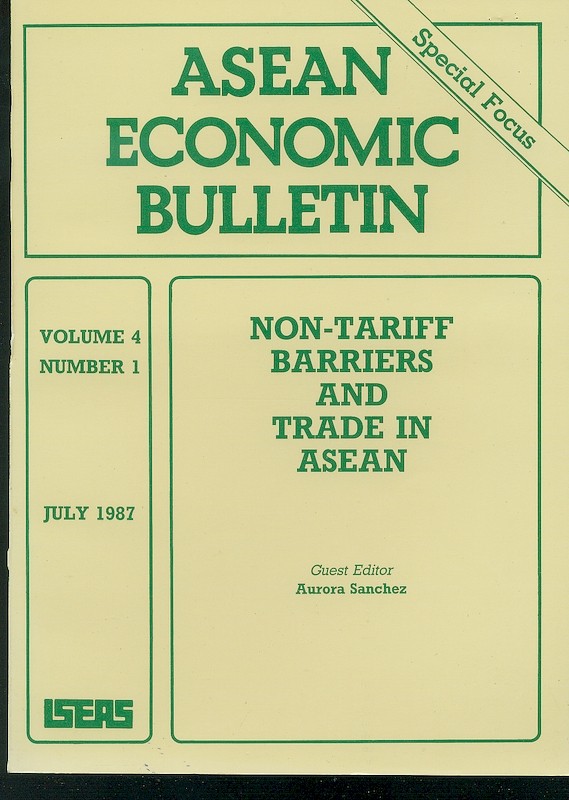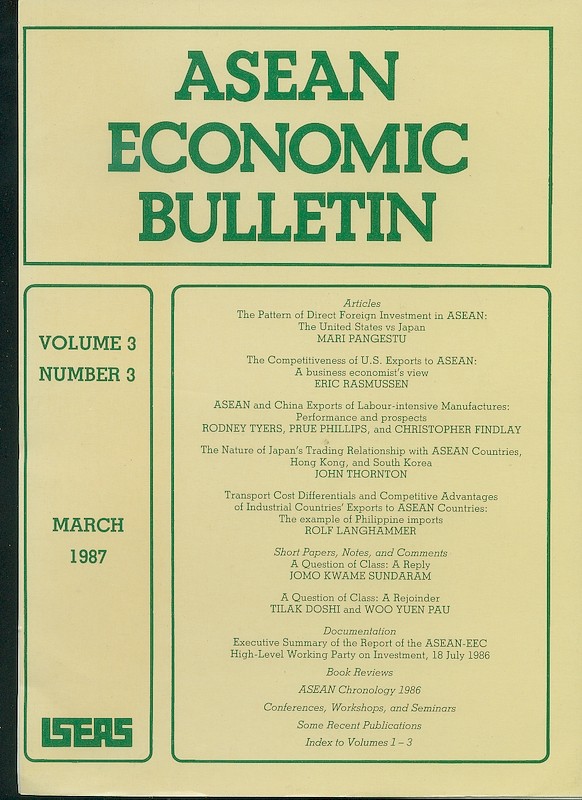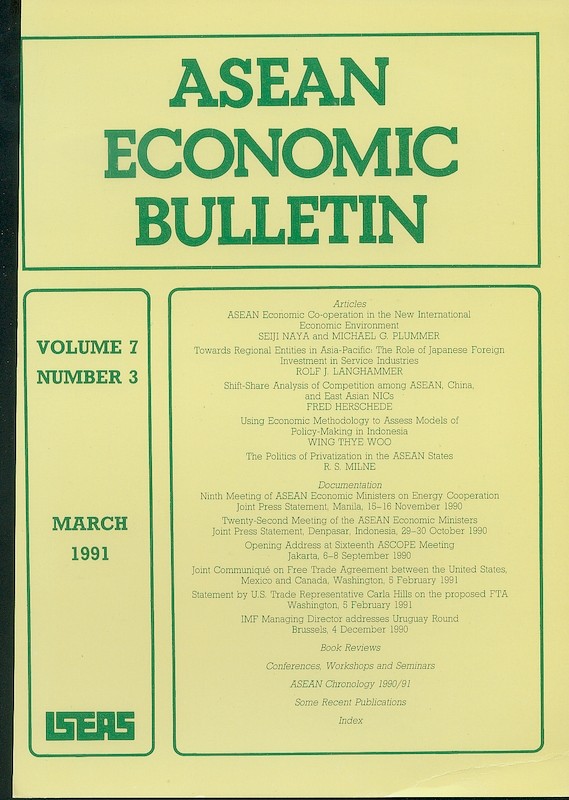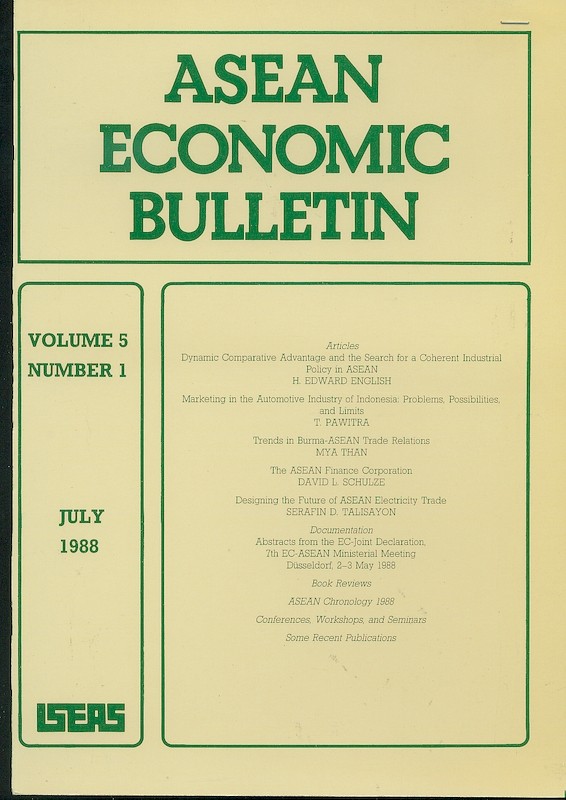ASEAN Economic Bulletin Vol. 4/3 (Mar 1988)
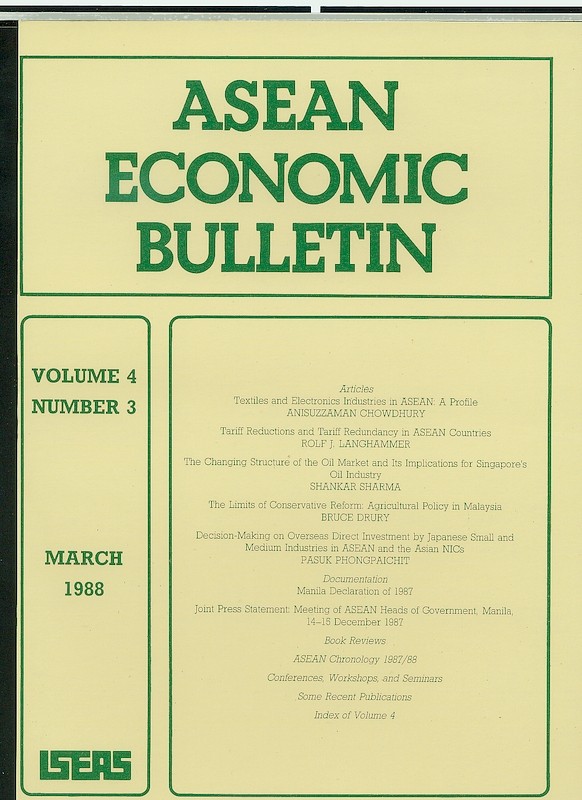
Date of publication:
March 1988
Number of pages:
111
Code:
AE4/3
Contents
-
Preliminary pages
- ARTICLES
-
Textiles and Electronics Industries in ASEAN: A Profile, by Anisuzzaman Chowdhury, author see abstractTextiles and garments (T&G) and electronics are two major industrial activities in the member countries of ASEAN. As the advanced East Asian newly industrializing countries (NICs), which include Singapore, are phasing out their labour-intensive operations, the second-tier NICs in ASEAN are expected to find comparative advantage in T&G and electronics assembly. Hence, these two industrial activities are the focus of the industrial programmes in Indonesia, Malaysia, the Philippines, and Thailand. This paper provides a profile of T&G and electronics industries in the ASEAN countries. The discussion focuses on the following aspects of these two industries: (i) the position within the industrial structure; (ii) the pattern of development; and (iii) factor intensity. The discussion on factor intensity is intended to shed some light on the implications for manpower policy.
-
Tariff Reductions and Tariff Redundancy in ASEAN Countries, by Rolf J Langhammer, author see abstractThis paper analyses the impact of exchange rate changes, changes in domestic and world prices and tariff reductions on the change of positive tariff redundancy, that is, legal protection through nominal tariffs exceeding the difference between domestic and world prices. The analysis undertaken for consumer goods supplied in four ASEAN countries (Indonesia, the Philippines, Thailand, and Singapore) finds domestic inflation and exchange rate changes to be more important determinants of changes in tariff redundancy than tariff cuts. This especially holds true for ASEAN countries with relatively high inflation rates, i.e., the Philippines and Indonesia.
-
The Changing Structure of the Oil Market and Its Implications for Singapore's Oil Industry, by Shankar Sharma (A), author see abstractThis study examines the implications of market change brought about by oil price disruptions to Singapore refineries and looks at the potential challenges to the industry. Singapore's refining industry, domestic oil consumption pattern, refined products, and petroleum product trade are described, as are the opportunities available to promote the oil industry in Singapore. The policy implications of the study are then presented and summarized.
-
The Limits of Conservative Reform: Agricultural Policy in Malaysia, by Bruce Drury, author see abstractMany developing countries exhibit a dualistic society where a modern industrial urban sector co-exists alongside a very traditional rural sector. If the rural sector is not modernized, it becomes a significant impediment to the overall economic and political development of the nation. Political leaders in Malaysia, recognizing that a modern agricultural sector is needed to provide food for a growing population, to generate foreign exchange needed for investment, and to maintain a stable political base for the ruling group, have constructed an agricultural reform package that was intended to eliminate rural poverty, increase productivity, and reduce inequities in the distribution of wealth. Unfortunately, the Malaysian reforms do not constitute a comprehensive agrarian reform programme. The results are massive food imports, a more unequal distribution of the wealth and a potential for rural unrest.
-
Decision-Making on Overseas Direct Investment by Japanese Small and Medium Industries in ASEAN and the Asian NICs, by Pasuk Phongpaichit, author see abstractIn the sixties and the seventies, overseas direct investment from Japan to ASEAN came mainly from the large conglomerates. Since the G-5 meeting in September 1985, and since the ensuing rapid appreciation of the yen, more Japanese overseas investment has come from small and medium industries, which form the majority of Japanese industrial enterprises. This paper discusses the causes of this new wave of overseas investment from Japan to ASEAN and the Asian NICs, and the decision-making process in Japanese small and medium industries (SMIs). It also looks at the levels of the investment flows and types of investment which may come to ASEAN in the future.
-
DOCUMENTATION: Manila Declaration of 1987
-
DOCUMENTATION: Joint Press Statement of the Meeting of ASEAN Heads of Government, Manila, 14-15 December 1987
-
BOOK REVIEWS: Industrialisation and Labour Force Processes: A Case Study of Peninsular Malaysia, by T G McGee et al., by Pasuk Phongpaichit, author
-
BOOK REVIEWS: Energy Policy Experience of Asian Countries, by Asian Development Bank, by Shankar Sharma (A), author
-
BOOK REVIEWS: The Philippine State and the Marcos Regime: The Politics of Export, by Gary Hawes, by Bhanoji Rao, author
-
ASEAN Chronology 1987/88
-
Conferences, Workshops and Seminars
-
Some Recent Publications
-
Index of Volume 4

